ODOT fleet ready for winter weather
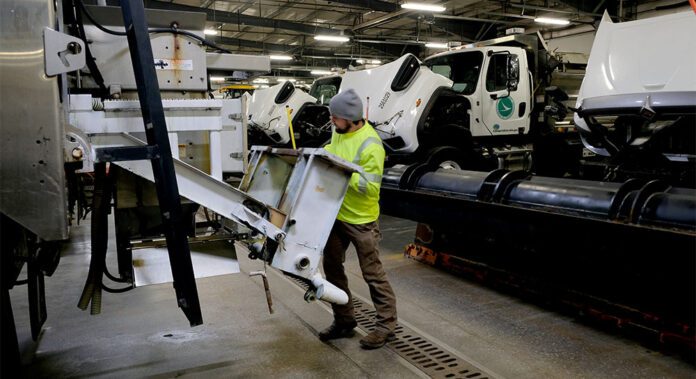

Advice for motorists: ‘Ice and snow, take it slow.’
MAUMEE – In anticipation of today’s forecast of 1-3″ of slushy accumulation and up to 1″ of snow throughout parts of Lucas County, Ohio Department of Transportation (ODOT) mechanics and drivers at the Lucas County Garage were busy preparing many of their 16 plow trucks for the road.

“Currently here at Lucas (County Garage), we started getting our trucks ready for the possible event that may happen this afternoon and this evening,” said Brian Drewes, transportation manager of the Lucas County Garage. “It’s important we go over all of this stuff so we know we can get through the storm without any issues.
“We also want everybody to keep in mind that our drivers are out and to give them their space so we can get home with our families,” he said.
Safety is a primary concern for ODOT. Last winter, ODOT plow trucks were struck 22 times while engaged in snow and ice operations. Ohio’s Move Over law requires drivers on state highways to move over a lane or slow down when approaching a stationary vehicle with
flashing lights, no matter the season or color of the flashing lights.


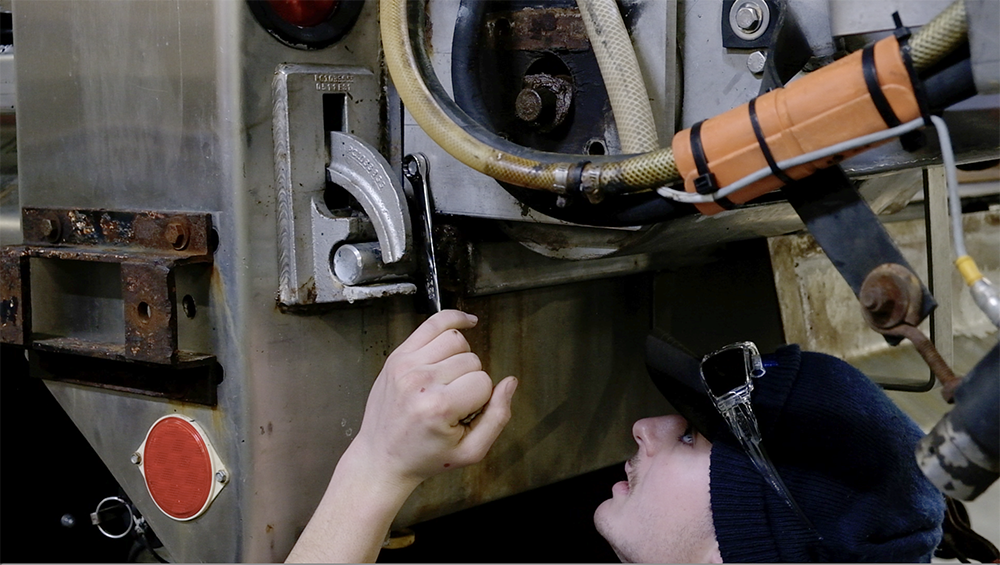

As winter weather arrives, snow and ice make roads slippery and dangerous. These conditions increase the chances of a vehicle accident. To make the roads safer, ODOT works tirelessly to stay prepared for winter storms.
Kelsie Hoagland, public information officer for ODOT District 2, discussed during a recent press conference at the Lucas County Garage how ODOT prepares for weather events by keeping the roads clear and salted. District 2 serves Fulton, Henry, Lucas, Ottawa, Sandusky, Seneca, Williams and Wood counties in northwest Ohio, and is headquartered in Bowling Green.
“We have mechanics at each of our garages that regularly maintain our vehicles, and we do in-depth snow and ice inspections, where we actually do a deep dive in identifying any miscellaneous problems that might be overlooked,” Hoagland said.
She added that they also send the mechanics to the Bowling Green garage or bring in district garage mechanics from Bowling Green.
Hoagland explained that the garage considers weather conditions and snowfall rates to keep the roads safe, and they take into account the many different types of weather events that can come in, whether it has ice, heavy snow, light snow, winds.
She also discussed the process that takes place before and during a snowstorm. “We have two shifts – A shift and B shift – and then we run those at a rolling 12 hours throughout a winter event. So, if a storm is going to start with rain, we cannot do any pre-treating, but if the temperatures are cold enough that it’s going to start with snow, then we can do things like pre-treat the roads with Brine, which is a saltwater combination.”
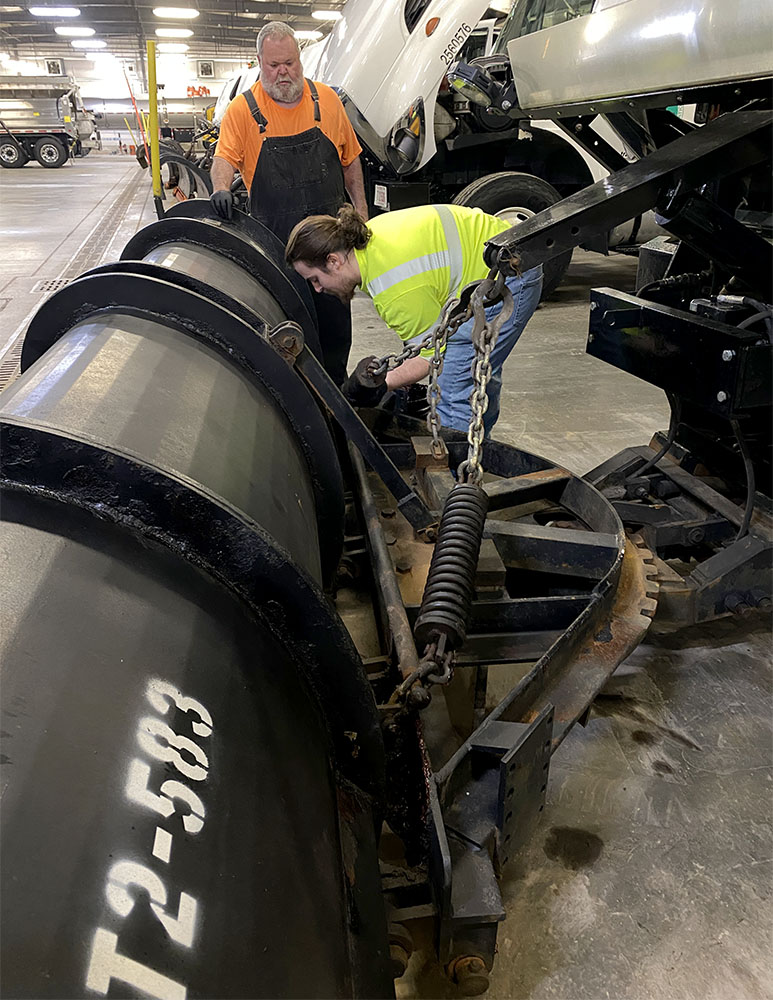

She clarified that Brine are the white stripes you see on the roadway before winter events. If a storm is going to begin with rain, it cannot be used because the rain will wash it away. Rock salt is also put on the roads for snow and ice.
Hoagland noted that each county is responsible for monitoring the weather, which is done through checking local news stations and other weather networks. After that, they roll into shifts for pretreatment (if applicable), followed by shifts after the snow begins to fall. Workers stay on 12-hour shifts until the snow is gone and the road is restored to normal conditions.
Hoagland offered advice for how regular drivers can help the ODOT driver.
“’Ice and snow, take it slow.’ That’s one of our slogans. And ‘don’t crowd the plow’ is another one that’s really focused on helping our drivers,” she said.
“It helps the motoring public because when you’re too close to our trucks, they can’t see you, and you are not having the best benefit of their work. You’re not actually getting the protected roadway. So, if you’re actually driving into the salt, it hasn’t had the chance to work yet. Give the room space, the truck space.”
She also recommended motorists keep materials, like a blanket or bottled water, in their vehicles in case they are ever stranded, and keep tires at the correct PSI.
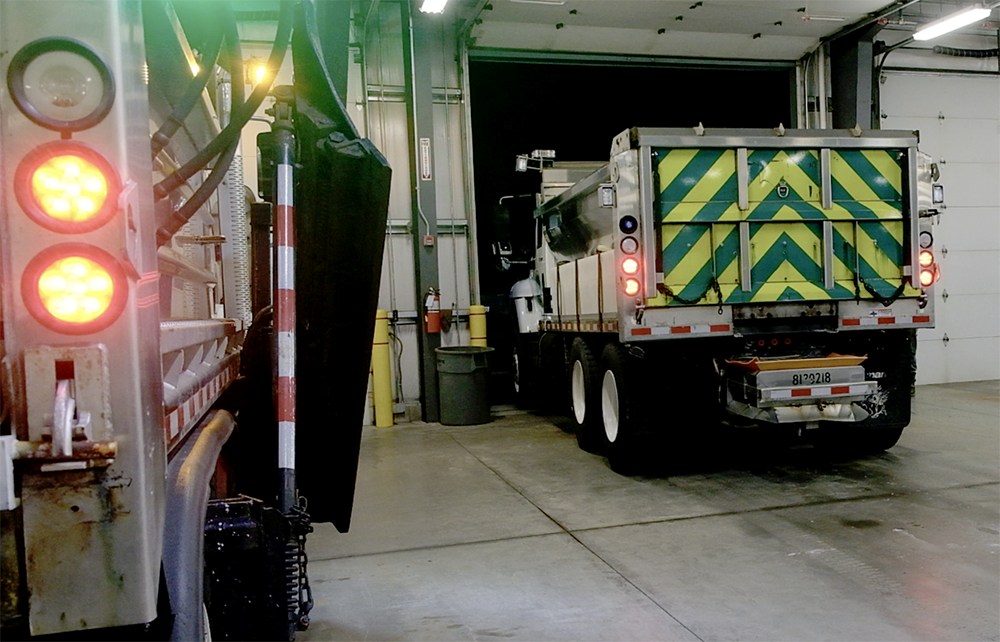

End-of-year reflections and gratitude


As the year comes to a close, I want to take a moment to thank all our readers, donors and subscribers for supporting our mission of providing local journalism that matters.
Reflecting on the past six months, I’m amazed at what we’ve accomplished in such a short time. Since June 3, when the TFP board hired me as the editor-in-chief, we’ve been busy moving into our office above the Blarney Irish Pub at 605 Monroe St. (a heartfelt thank you to everyone who donated desks, chairs, tables, and even a fridge). We’ve hired staff, freelancers, and interns; built a website; secured funding to help keep us operational; and worked to spread the word that we’re up and running as a nonprofit, online-only local newsroom.
At this point, we only publish one story and cartoon a day, but that will hopefully increase as our staffing increases (my New Year’s resolution). We are also developing a podcast page, and will not only have our own podcast shows, but we’ll host other local podcasters, like Stage Door and Jaden Jefferson Reports.
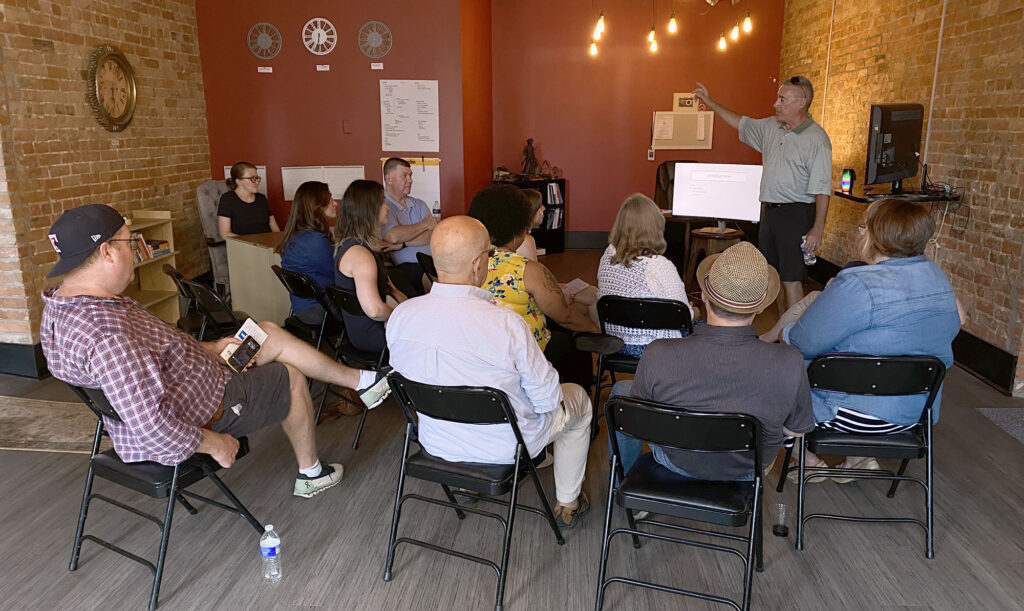

By the way, I no longer call the TFP a newspaper—after all, we don’t publish hard copies anymore. It’s a tough habit to break, considering I’ve been in the print newspaper business since 1980. But times have changed. It’s now the 21st Century, and how we disseminate news has changed dramatically. We’re witnessing the fast disappearance of legacy newspapers in our own lifetime, something I never thought would ever happen. At least we’re saving trees …
Unfortunately, as newspapers fade, news deserts and ghost newspapers are on the rise. According an executive summary in a 2024 report of The State of Local News, more than 3,200 print newspapers have vanished since 2005. In 2023 alone, 130 newspapers ceased operations. Imagine the void left in communities without journalists reporting on local events; uncovering corruption; and holding public officials who make our policies accountable.
It’s our job as a nonprofit newsroom, which are thankfully increasing, to shed light on the truth and serve our community. Read the 2024 report … the details are alarming.


When I taught journalism and media communication at Owens, the University of Toledo, and Wayne State, I always surveyed students on the first day of class about their news habits. I was initially shocked that most of them had never read a newspaper. That’s right … never.
Those who did pay attention to news got it from social media, like X (formally known as Twitter and now owned by billionaire Elon Musk, who makes you pay for a blue checkmark rather than earn it); TikTok (which capitalizes on partisan algorithms, though its fate is nigh); Facebook (now capitalizing on paid boosts to share content); and podcasters, YouTube and online news sites, like Patch, Axios and Vox.
What hasn’t changed? The absolute necessity for journalism to remain fair, balanced, verifiable and reliable.


Starting a newsroom from scratch is no small task, and we expect growing pains for at least another year. Building a strong identity that resonates with the community takes time. I appreciate your patience as we work to fulfill our mission of telling your stories ethically and responsibly.
One of our biggest challenges is simply letting northwest Ohioans know we exist. How can we thoroughly cover Toledo without reader input and news tips? We don’t want to rely solely on press releases.
So, here’s my ask: If you like what we are doing, please share our content on social media, and continue supporting us as we grow.
I also ask that you keep us accountable, as well. Help us ensure that we’re meeting your expectations. If you see something—good or bad—please let us know. You can contact me at loriking@toledofreepress.com.
Before I close, I want to highlight three key tools on our website:
• The Donation Button: This button takes you to our Patreon, PayPal and First Amendment Society links. Your contributions help employ our journalists and keep the Toledo Free Press completely free. Donors also receive a weekly newsletter with updates on new hires, staff profiles, event announcements and more.
• The Subscription Button: Sign up for Kelly McGilvery’s weekly newsletter, which recaps published stories and behind-the-scenes insights.
• The Story Tip Line: Use this to let us know what’s happening in your neighborhoods.
The staff (Erin Holden, Kelly McGilvery and Stephen Zenner) and our board members thank you for supporting local journalism. Together, we can ensure that Toledo and northwest Ohio have the robust news coverage you deserve.
Toledo’s probationary firefighters prepared for duty


TRFD Academy celebrates its current class with Family Day
This is Part 2 of a limited series about the current Toledo Fire & Rescue Academy class.
Story by Paula Wethington | Photos Courtesy of Toledo Fire & Rescue
WALBRIDGE – Toledo Fire & Rescue Department’s newest class of probationary firefighters have earned their assigned stations after being sworn in during a ceremony on Dec. 6.
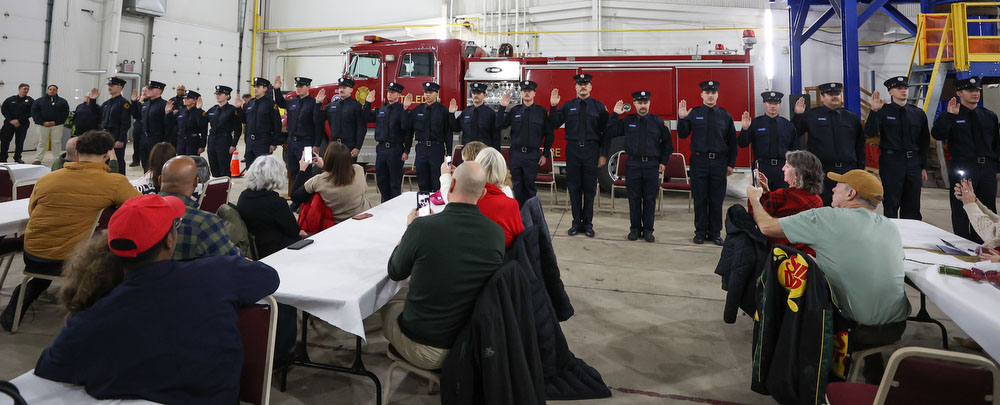

The ceremony took place during the academy’s Family Day program at the Center for Emergency Preparedness Center on Tracy Road. The facility, designed for public safety and first responder training, is near the main campus of Owens Community College.
“I’ve always wanted to be a firefighter. I wanted to give back to my community,” said Aubrey Bruhn, 18, of Waterville, who was among those named to probationary firefighter rank that day.
Scott Bruhn, who described his daughter as “motivated,” explained his daughter did not wait for the 2024-25 fire academy to officially begin, but took her emergency medical technician class ahead of time. The schedule for EMT was tight, given her birthdate, but the accomplishment was earned.
Bruhn’s TRFD assignment is at Station 9. She met her station crew mates just one day before earning her rank.
Fire Academy Class 298
Toledo Fire Class 298 started its training Aug. 16 with 30 recruits. By early December, one was on an injury leave while 29 remained active in the program.
The class participants ranged in age 18 to 39, with some coming in from former careers, such as with the military. Those who already have EMT or paramedic certifications, like Bruhn, get station assignments after completing the firefighter training courses, while the rest continue with EMT-Basic classes.
A graduation ceremony for the academy class takes place Feb. 28.
Training their crew mates
Running a fire academy is a huge investment for the department, and it happens only as schedules and budgets permit.
One reason is that veteran personnel from across the city need to step out of their regular 24-hour-on/48-hour-off station assignments into instructor preparation and training hours to coincide with the recruits’ schedule. But that’s how TRFD wants to bring new personnel on board.
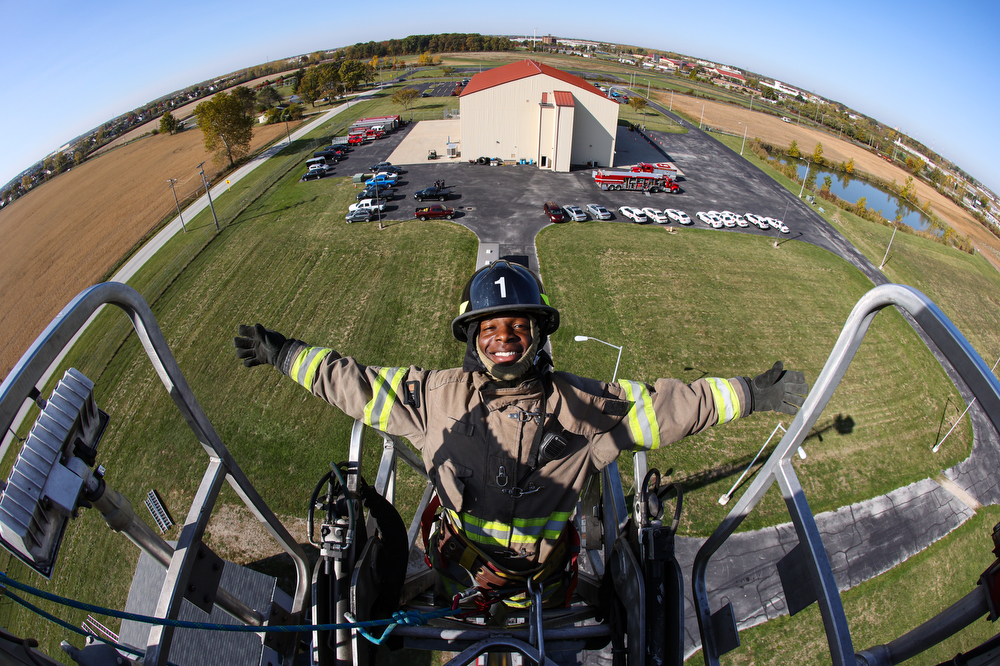

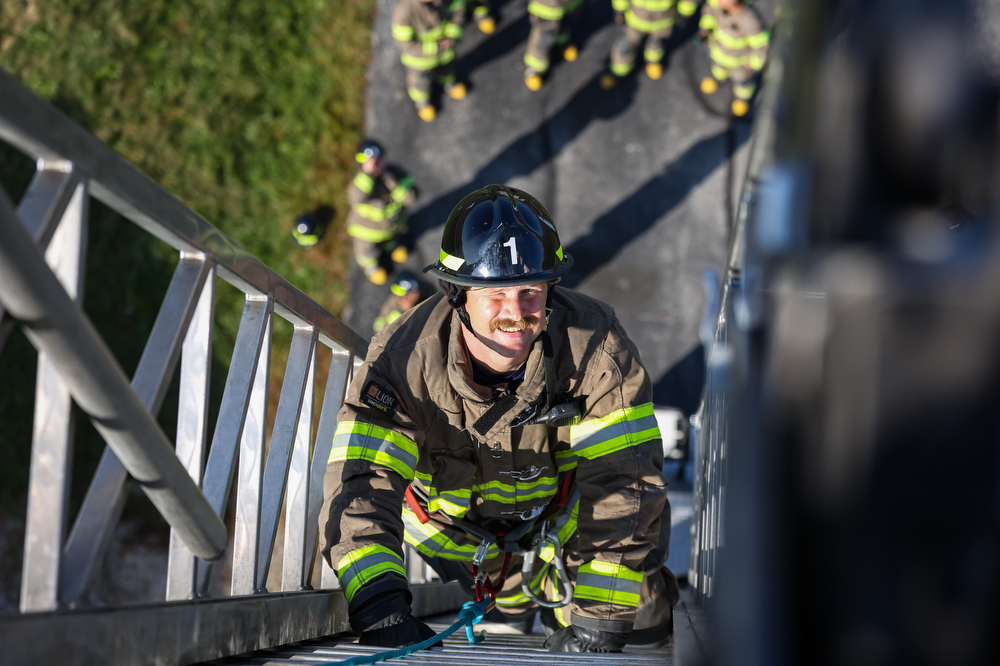

“They put forth effort, and we’ll get them to the finish line,” said Lt. John Rodriguez, who was among the academy instructors.
“I’m very proud to say they are coming to the line with me,” said Capt. Michael Romstadt, who led this year’s academy class. “It’s a very tough academy. We push them; we push them very hard.”
TRFD academy meets for 40 hours a week. Most of the classwork and training takes place at the Owens facility; some instruction takes place at Maumee Fire Division’s burn tower. The lessons include how to put out a structure fire, handling hazardous materials at a scene and how to operate the department’s equipment.
“I knew it was going to be very physical,” Bruhn said about the 16-weeks firefighter training. “But I didn’t expect how physical, and how good they got me in shape.”
Another classmate, recruit Shamonde Sanders, age 26, of Toledo, is a military veteran who had considered police work as his next career step. But then he decided on fire and rescue.
“This is a perfect opportunity to give back to the community,” Sanders said about his career path. “I think it is underrated how smart firefighters are, what they need to know and be prepared for at all times.”
The recruits are paid for academy training, and “we’re definitely getting our money’s worth,” Romstadt said.
Family Day celebration
Family Day is second only to graduation day itself within the academy. It marks the training achievements so far, and it is also a chance to meet and thank family and friends who supported recruits throughout the process.
The Dec. 6 ceremony and luncheon took place in the vehicle bay of the Owens training facility. It included speeches from the TRFD chief and other officials, introductions of the instructors and a roll call of the newest firefighters. Rev. Nicole Ritz, one of the TRFD chaplains, also gave a welcome and prayers.
The speeches and remarks included numerous acknowledgements for the family and friends at home.
“It’s the support system at home – you guys – that get this across the finish line,” Romstadt told their family and friends. “We talk a lot about tradition in the fire department. This is not a job: This is about service. This is about teamwork.”
Daniel Brown-Martinez, deputy chief of the training academy, encouraged the academy students to keep their passion for service. “Remember that it is a privilege and an honor to serve,” he said.
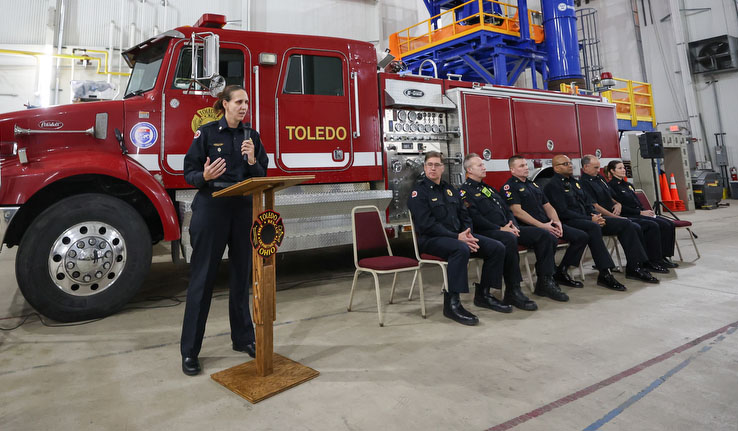

Then TRFD Chief Allison Armstrong gave her keynote speech.
“We know that they rely heavily on family and friends for support,” she said. “We chose a career of service.”
In their future roles, she reminded the audience, firefighters will have long and busy 24 hours before going home.
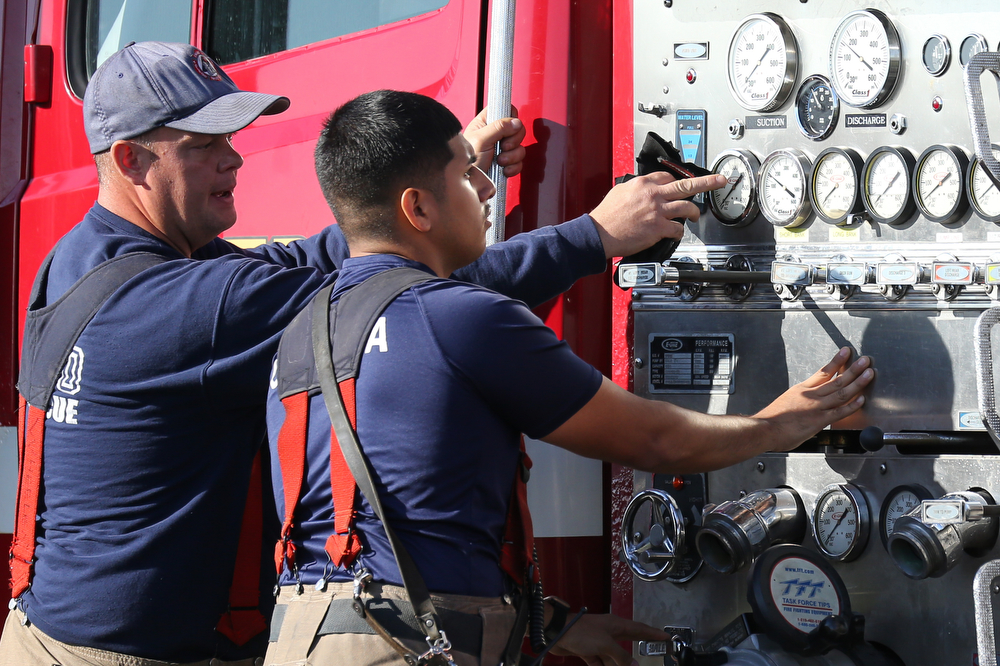

The firefighters are trained to respond to situations, such as a traffic accident or medical emergency. Under those conditions, the chief said, the firefighters are expected to treat the public with courtesy and professionalism. “People call us because they need help,” she said.
But there are also school visits, community events, parades, vehicle maintenance, training updates and smoke detector demonstrations.
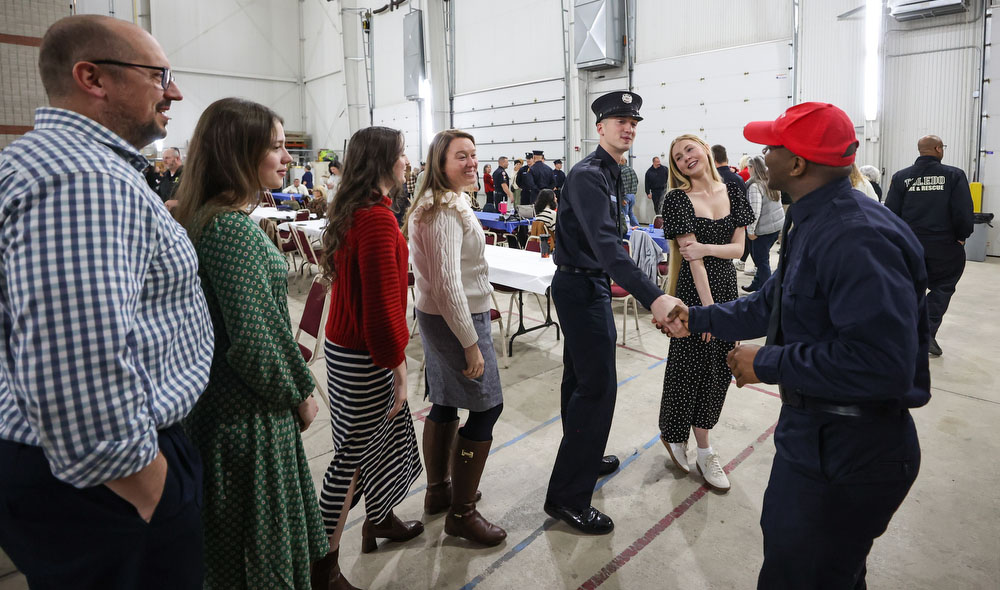

Armstrong instructed her new personnel that they are to be the first to get up and last to sit down when they arrive at their stations for a shift.
“Expect to be busy all day and prepare for that,” she said.
The 19 students who earned probationary firefighter status wore a full black dress uniform with the TRFD patch and cap. After the speeches, they lined up at attention in front of a Toledo fire truck to raise their right hands and recite the department’s oath of office.
The remaining 10 recruits who will continue on in the academy wore a simpler uniform and a red hat. Those recruits sat among the audience, but stood to join their classmates in the chant: “We will serve our community. We will inspire.”
What’s next?
Toledo’s newest firefighters spend a year rotating around three different stations.
TRFD has 18 stations across the city, and while the crews primarily work within the city limits, the department participates in mutual aid calls with neighboring fire districts as needed.
With upcoming city budgets currently under discussion, it’s not clear when the next academy class will begin. Romstadt said they like to start that series in the summer so that any training that needs to take place outdoors can happen amid ideal weather conditions.
Romstadt and Rodriguez said the schedule and personnel selected for each academy is intended to stay ahead of pending and expected retirements.
BIZ HUB BRIEFS
Imagination Station bounces in the New Year Dec. 30
| It’s time to ring in 2025 with a bounce! 25,000 bouncy balls will fall from the ceiling of Imagination Station Dec. 30 at 2:25pm to celebrate New Year’s Eve Eve. There are five New Year’s activities for the whole family to try—alongside other exhibits and attractions—as you wait for the main event. Create noisemakers, decorate foam 2025 glasses, make a straw kazoo, discover shrinking art and join the Fort Fest for a snowball fight. Tickets to New Year’s Eve Eve will be available at the door beginning at 10 a.m. – 5 p.m. New Year’s Eve Eve is included in all memberships. Admission is first-come, first-served. |
La-Z-Boy, Inc. to acquire Toledo locations
Set to take effect in January, La-Z-Boy, Inc. will officially acquire Durocher’s two Toledo La-Z-Boy stores: La-Z-Boy Home Furnishings & Décor at 5178 Monroe St. in Toledo and La-Z-Boy Furniture Galleries at 5804 Airport Hwy. in Holland.
As part of the transition, partners and advertisers are told all existing contracts for these La-Z-Boy locations will end on December 31, 2024. Future inquiries and advertisement propositions should be directed to La-Z-Boy’s corporate office. Partners of Durocher’s Sylvania and Monroe, Mich. locations should continue to contact them directly about future advertising.


TARTA honored by Ohio Public Transit Association
The Toledo Area Regional Transit Authority (TARTA) was honored last month for its services to the Toledo area and efforts to create a better ride experience for sensory-sensitive passengers, receiving two awards from the Ohio Public Transit Association (OPTA). The TARTA paratransit team was given the Collaborative Excellence Award for becoming the first Ohio transit agency division to be named a Certified Autism Center, part of a larger effort with Destination Toledo to make the city a Certified Autism Destination. Information Operator Lynette Stanley was presented with the Milestone Award, recognizing her 28+ years of customer dedication, making her the third Team TARTA member to receive the award in as many years.
Assisted Living Locators now serving Toledo


With a new location in Toledo, nationwide senior placement and referral service Assisted Living Locators will provide families with no-cost aid in the search for senior care options — be it independent living, assisted living, memory care, or in-home care. Under the leadership of Mohammed Al-Fadhel, a University of Toledo alum, Assisted Living Locators helps families sift through the overwhelming amount of available senior care options.
Services include personalized assessments of senior living facilities, an online care planning tool, guided tours and placement support, financial guidance and resources, emergency placement assistance, and ongoing support throughout the entire placement process.
For more information, call Mohammed Al-Fadhel at 213-550-6272 or visit their website.
Bringing Kava Culture to Toledo
Opening soon, Kava Culture Kava Bar is a non-alcoholic bar and lounge, located at 4701 Talmadge Rd.. With a concept centered on community and the earth, Kava Culture encourages people to socialize and build connections, providing the environment to do so while serving up traditional kava, botanical teas, non-alcoholic cocktails, coffee, and vegan treats.
For updates, follow Kava Culture Toledo on Facebook and Instagram or email toledo@kavaculturefranchise.com.
Bolt Express named Ground Carrier of the Year
Transportation brokering service RXO has recognized Bolt Express, provider of Time-Critical Transportation Solutions®, as Ground Expedite Carrier of the Year. The Toledo-headquartered Bolt Express credits this achievement to their continued investment in technology, introducing new advancements for their customers and drivers, dedication to employees, and commitment to quality. Integration of Bolt Express’ new Bid App™ module, a high priority for their technology team this year, has aided in creating faster response times and has produced benefits for customers, drivers, and the company alike.
Toledo battles lead exposure


UToledo helps with lead screenings, education
TOLEDO – In October 2020, Toledo City Council made a commitment to eradicate harmful lead exposure to all tenants, especially children, by passing an ordinance requiring all rental properties of 1-4 units and daycare facilities constructed prior to 1978 to be lead-safe certified.
The effects of elevated blood levels in children, particularly those six years old and younger, are well documented. It often results in behavioral issues, like hyperactivity and angry outbursts, and it also prevents children from progressing in their studies at the same rate as their peers.
While the lead-safe ordinance (TMC 1760) is an important first step in preventing children from lead exposure, putting it into action has proven to be a long road. The ordinance has experienced legal disputes: In 2022, a suit was filed against the city by landlord Charmarlyn Strong, resulting in an injunction. A judge did rule in favor of the ordinance last year, but the lawsuit is being appealed. Until the injunction is lifted, enforcement of the ordinance is on hold.
The ordinance created deadlines for rental properties and daycare facilities to have received their certifications, and while many have, the hold up in court has made it impossible to penalize those who haven’t complied. If the injunction is lifted, fines and penalties — even a first-degree misdemeanor — could be applied to those who haven’t gone through the certification process.
Monica Smith, lead coordinator for the City of Toledo, says that the compliance dates (many of which have long since past), are prioritized in order of lead risk.
“According to the CDC Center for Disease Control, every zip code in the city is considered high risk for land poisoning,” Smith said. “However, we know that some are higher than others. So, when the decision was made to create that timeline in regards to the compliance dates, that was based off the number of children who had elevated lead levels at that time. We prioritized the areas where the rates were higher.”
Steps for rental owners
The Lead Safe Toledo website makes it easy for Toledo renters and daycare facilities to become certified, but Smith has some tips to emphasize.
- Ensure your property has been registered with the Lucas County auditor’s office. It needs to be registered on the rental registry.
- Visit toledoleadsafe.com to learn how to clean the property prior to inspection.
- Identify the clearance technician or the risk assessor you’re going to hire to do your clearance examination on your property. Those are also listed on the Toledo Lead Safe website.
- Once you have hired one of these independent contractors to perform a clearance exam and received their report, go to the Toledo Lead Safe website to apply for your certificate ($25 fee).
All of these steps have links and resources on the website, including what your compliance date is for your property’s zip code.
Toledo – we have a problem
Teachers, parents and concerned community members have to remain diligent in advocating for kids facing health risks that could impact their lives well into adulthood.
Dr. Marilynne Wood, a retired professor of nursing at the University of Toledo, began screening children for lead poisoning over a decade ago and has since tested well over 1,000 children for exposure. Along with screenings and home visits, Wood leads educational initiatives at health fairs, churches and parent-teacher organizations, with the hope of raising awareness and making real change for these children.
Through these screenings she’s conducted with UT students from the College of Medicine and College of Nursing, Wood found that “we have a real issue in Toledo. Some of our areas, especially in the North End in Leverette, and some of our elementaries around there, when the children were screened, 70 percent of the children at Leverette were elevated. Ninety percent of our housing there was built before 1978, many of those homes even before 1950.”
1978 is when lead-based paint became illegal and, since then, there has been a long, slow movement toward dealing with the consequences it continues to leave in its hazardous wake. Central Toledo is particularly affected, and Wood has found a pervasive presence of lead in certain zip codes. She has served on the executive board of the Lead Poisoning Prevention Coalition for many years as well.


“I don’t see a trend of decrease over the city,” she points out. “Some of the zip codes are so predictable: 43605, 43607, 43608, 43609. Our Old South End. I’d like to target the schools in these areas because I know we need to do so many interventions there.”
Identifying lead poisoning and what you can do
The problem with identifying lead poisoning in children is that the symptoms are often not apparent until the child has been exposed for some time.
“A lot of parents don’t even know that this could be an issue and why their child isn’t doing very well in school,” says Wood, adding that it often becomes more obvious in the third grade. Falling behind even this early on can prevent a child from reaching their potential for years to come, and there is even evidence that lead poisoning correlates with rates of suspension in high school, Wood explains.
Once your child has been tested for lead poisoning, there are steps you can take to limit their exposure:
- Diminish the effects by making sure your child stays full (more lead is absorbed into the bloodstream on an empty stomach)
- Put them on a multivitamin and nutritious diet
- Pregnant moms-to-be should be mindful of their exposure to lead to maintain healthy fetal development
- Environmentally, you should have an assessor come to your home to see where the problem lies so that it can be addressed. Toledo Lucas County Health Department has resources to help you with finding an assessor and testing your child for lead.
- There might be peeling paint in the interior and/or exterior of the home, and lead could be present in the soil, contaminating it and any food you try to grow there. If this is the case, you should opt for elevated vegetable gardens to avoid these contaminants.
- The City of Toledo’s Department of Neighborhoods can also point residents, daycare owners, and landlords in the direction of funding through grants. All changes to the property may very well be covered for you as the homeowner, or for your landlord if you are renting.
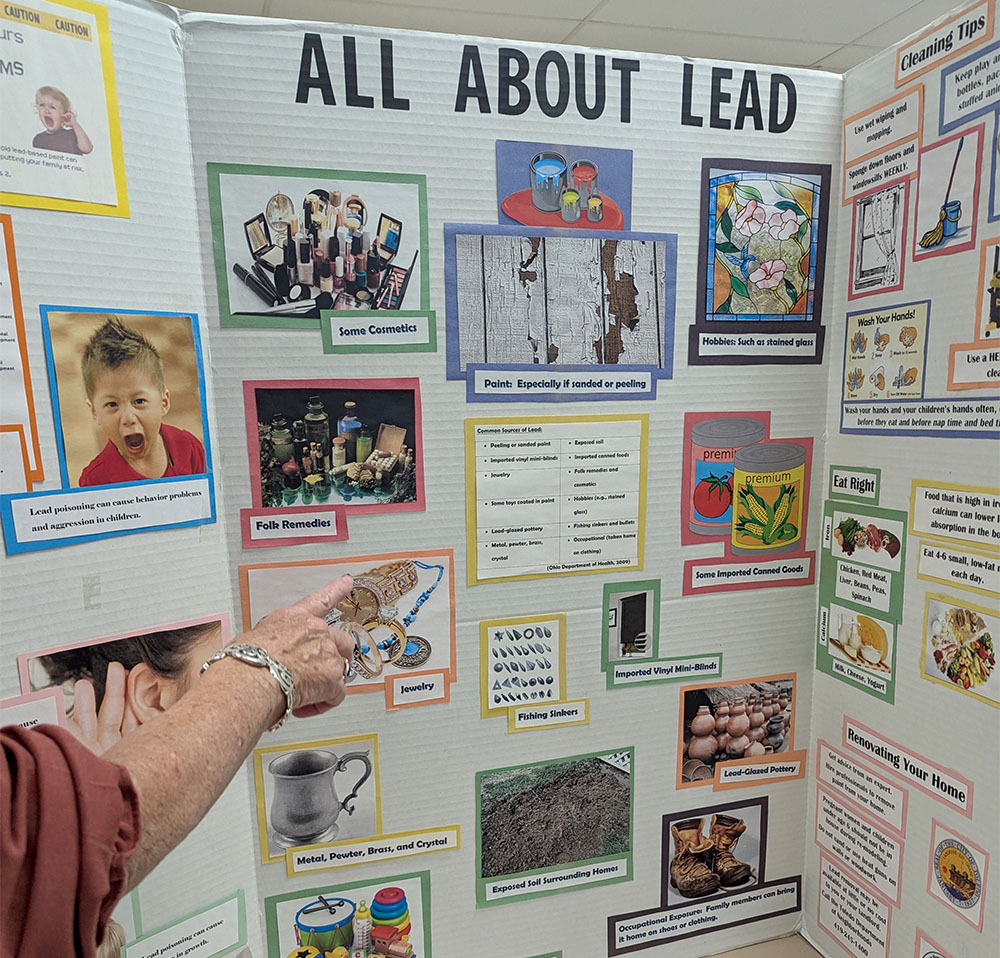

In the meantime…
Even though enforcement of the lead ordinance is on hold, many owners of rental properties have taken the initiative to register their properties, go through any necessary lead abatement, and receive their certifications as lead safe properties.
For families who are living in a home with lead, there are still measures they can take to keep themselves as safe as possible from lead exposure.
Make sure your home and the daycare you send your child to are safe. If you work in an industry where you are exposed to lead — welding, for instance — avoid letting your child near you until you’ve changed your clothes. It can be difficult to remember these precautions, but the consequences of complacency are dire.
“If there’s a little one — a toddler, a child under six — in the home, those are the ones we’re most worried about because their brains are developing, and that’s the time for the most damage,” Dr. Wood said.
“I think on their list of things that are important [to many parents], it’s food and shelter and not worrying about what their [child’s] lead level is. And I think it’s such an important thing because it’s something we can do something about through education. These kids are completely dependent on where they live, and we need to help them.”
To seek testing for lead poisoning or to have your home inspected for lead, contact the Toledo Lucas County Health Department at 419-213-4100.








